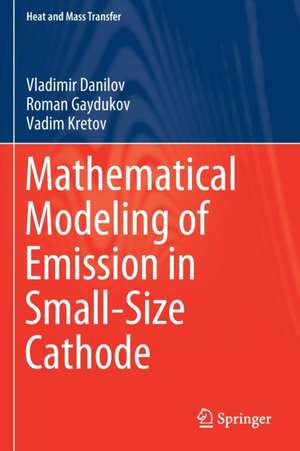Mathematical Modeling of Emission in Small-Size Cathode: Heat and Mass Transfer
Autor Vladimir Danilov, Roman Gaydukov, Vadim Kretoven Limba Engleză Paperback – oct 2020
| Toate formatele și edițiile | Preț | Express |
|---|---|---|
| Paperback (1) | 636.12 lei 6-8 săpt. | |
| Springer Nature Singapore – oct 2020 | 636.12 lei 6-8 săpt. | |
| Hardback (1) | 642.18 lei 6-8 săpt. | |
| Springer Nature Singapore – oct 2019 | 642.18 lei 6-8 săpt. |
Din seria Heat and Mass Transfer
- 18%
 Preț: 1002.27 lei
Preț: 1002.27 lei - 15%
 Preț: 637.78 lei
Preț: 637.78 lei - 15%
 Preț: 647.92 lei
Preț: 647.92 lei - 15%
 Preț: 579.99 lei
Preț: 579.99 lei - 15%
 Preț: 649.39 lei
Preț: 649.39 lei - 18%
 Preț: 948.79 lei
Preț: 948.79 lei - 18%
 Preț: 990.44 lei
Preț: 990.44 lei - 20%
 Preț: 993.74 lei
Preț: 993.74 lei - 18%
 Preț: 945.30 lei
Preț: 945.30 lei - 18%
 Preț: 887.24 lei
Preț: 887.24 lei - 15%
 Preț: 644.18 lei
Preț: 644.18 lei - 15%
 Preț: 645.28 lei
Preț: 645.28 lei - 18%
 Preț: 1236.19 lei
Preț: 1236.19 lei - 18%
 Preț: 950.96 lei
Preț: 950.96 lei - 18%
 Preț: 947.35 lei
Preț: 947.35 lei - 18%
 Preț: 947.85 lei
Preț: 947.85 lei - 15%
 Preț: 639.41 lei
Preț: 639.41 lei - 18%
 Preț: 953.97 lei
Preț: 953.97 lei - 15%
 Preț: 640.88 lei
Preț: 640.88 lei - 15%
 Preț: 657.08 lei
Preț: 657.08 lei - 18%
 Preț: 957.62 lei
Preț: 957.62 lei - 18%
 Preț: 957.44 lei
Preț: 957.44 lei - 18%
 Preț: 943.25 lei
Preț: 943.25 lei - 18%
 Preț: 1109.29 lei
Preț: 1109.29 lei - 18%
 Preț: 955.70 lei
Preț: 955.70 lei - 15%
 Preț: 642.83 lei
Preț: 642.83 lei - 18%
 Preț: 1214.38 lei
Preț: 1214.38 lei - 15%
 Preț: 649.71 lei
Preț: 649.71 lei - 18%
 Preț: 950.66 lei
Preț: 950.66 lei - 15%
 Preț: 645.47 lei
Preț: 645.47 lei - 18%
 Preț: 1002.13 lei
Preț: 1002.13 lei - 15%
 Preț: 636.12 lei
Preț: 636.12 lei
Preț: 636.12 lei
Preț vechi: 748.38 lei
-15% Nou
121.72€ • 127.35$ • 101.11£
Carte tipărită la comandă
Livrare economică 03-17 aprilie
Specificații
ISBN-10: 9811501971
Pagini: 194
Ilustrații: XII, 194 p. 77 illus.
Dimensiuni: 155 x 235 mm
Greutate: 0.3 kg
Ediția:1st ed. 2020
Editura: Springer Nature Singapore
Colecția Springer
Seria Heat and Mass Transfer
Locul publicării:Singapore, Singapore
Cuprins
Preface
Chapter 1. Introduction
1.1. Brief history of the electron emission discovery
1.2. Types of electron emission
1.3. Statement of the problem
1.4. Mathematical statement of the problem. Heat transfer model
Chapter 2. Physical foundations of field emission
2.1. Band theory and Fermi levels
2.2. Specific conductance of semiconductors
2.2.1. Electron and hole concentration2.2.2. Effective mass
2.2.3. Electron and hole mobility
2.2.4. Temperature dependence of specific conductance in silicon
2.3. Thermoelectricity
2.4. Heat conduction of solids
2.4.1. Electron heat conductivity
2.4.2. Heat conduction of crystal lattice
2.5. Emission current density and Nottingham effect
2.5.1. Support function in metals
2.5.2. Electron tunneling through potential barrier
2.5.3. Formula for the barrier transmission factor in the case of field emission cathode
2.5.4. Emission current density in metals
2.5.5. Specific characteristics of filed emission from semiconductor cathode
2.5.6. Approximation of the emission current density formula
2.5.7. Nottingham effect
2.5.8. Optimal values of approximation parameters
2.5.9. Inversion temperature dependence on the external electric field voltageChapter 3. Mathematical model
3.1. Phase field system and its use in heat transfer modeling
3.2. Phase field system as regularization of limit problems with free boundary3.3. Asymptotic solution of the phase field system and modified Stefan problem
3.3.1. Construction of asymptotic solution
3.3.2. Examples
3.4. Weak solution of the phase field system and the melting zone model
3.4.1. Weak solutions and Hugoniot-type conditions
3.4.2. ``Wavetrain''-type solutions and the corresponding limit problem
3.5. Derivation of the limit Stefan-Gibbs-Thomson problem solution from numerical
solution of the phase field system
3.6. Generation and merging of dissipative waves
3.7. Cathode in the vacuum cube. Definition of a generalized solution to Poisson
equation for electric field potential
3.8. Mathematical model of electron emission in a vacuum cubeChapter 4 Numerical modeling and its results
4.1. Nanocathode model
4.2. Computation of current density inside the cathode
4.3. Computation of emission current density and Nottingham effect modeling
4.4. Difference scheme
4.4.1. Difference scheme for the equation for the potential
4.4.2. Difference scheme for the equation for the function of order
4.4.3. Difference scheme for the heat conduction equation
4.4.4. Difference scheme stability
4.4.5. One more version of the difference scheme4.4.6. Choice of the difference scheme step
4.5. Algorithm for solving difference equations and possible versions of
its parallelization
4.6. Results of numerical experiments
4.6.1. Nonmonotone behavior of free boundaries
4.6.2. Results of modeling with physical parameters corresponding to
experimental parameters4.7. Formation of melting and crystallizing nuclei in the model
4.8. ConclusionRecenzii
Notă biografică
Roman K. Gaydukov received the M.S. degree from the Moscow Institute of Electronics and Mathematics, Moscow, Russia, in 2012, and the Ph.D. degree from National Research University Higher School of Economics, Moscow, Russia, in 2016. He is currently an Associate Professor with the National Research University Higher School of Economics, Moscow. His current research interests include asymptotic methods, mathematical and numerical simulation, field emission, fluid mechanics and boundary layer theory.
